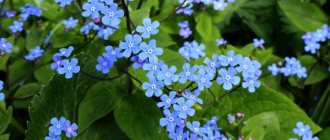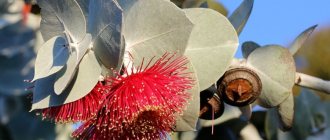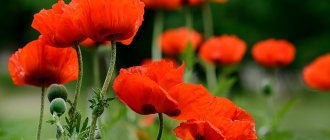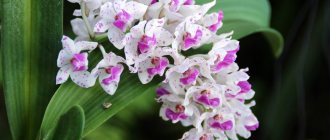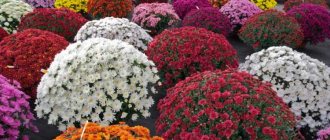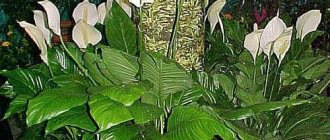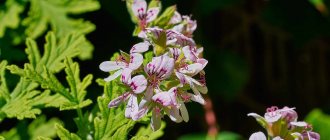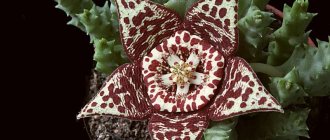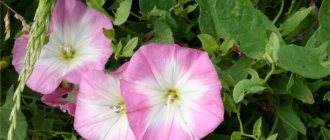lilac-pink double bracts.
'Double Orange' –
with double orange bracts; abundant flowering.
'Double Pink' –
double pink bracts with a greenish center.
'Double Red' –
with double fuchsia-raspberry bracts, the color remains the same throughout flowering; abundant flowering.
'Double Salmon' –
with double yellow-orange bracts with a pink center.
Bougainvillea spectabilis
The remarkable bougainvillea gained popularity back in the 19th century; it was found on rocky slopes in the tropical regions of Brazil.
However, in southern countries this plant was used as decoration for gazebos and greenhouses. This type of bougainvillea has large bracts and velvety leaves that turn pale when flowering.
Bougainvillea remarkable has fairly durable, pointed, heart-shaped leaves, slightly covered with hair on the back side. Remarkable bougainvillea has beautiful flowers; in this variety, at the ends of the branches they are collected in inflorescences, which open from April to mid-autumn. The flowers are up to 5 cm in length. Around the flowers there are usually up to three bracts of pink, purple or red hue. Every year the color of the stipule fades. The perianth is tube-shaped, yellow-green in color. The shoots of the plant are covered with thorns and can reach up to 9 meters.
What to do if bougainvillea doesn't bloom?
Quite often, the reason why a Bougainvillea flower cultivated indoors does not bloom is due to improper care.
For example, if the plant was not provided with the proper temperature conditions in winter, then it did not have a dormant period as such. The bush was unable to fully regain its strength and produce flower buds.
Also, the plant may not have received enough sunlight, since the duration of daylight hours for Bougainvillea is quite long. When a bush is planted in a very large container, the roots of the plant simply do not have time to absorb the entire volume of soil. In summer, during the period of active growth, Bougainvillea lacked light and heat. The amount of fertilizing or the amount of fertilizer applied was insufficient.
If all the conditions are met, but the inflorescences have not formed, you can try to make Bougainvillea bloom. First, stop feeding completely, then reduce the amount of watering. This care is continued until flower buds appear on young shoots. And as soon as they begin to form, it is necessary to immediately resume feeding and restore the previous volume of watering the plant.
Bougainvillea plant: photo of an indoor flower
Bougainvillea glabra
Bougainvillea naked can grow up to 5 meters, unlike bougainvillea remarkable, so most often this plant is used as a houseplant.
It tolerates pruning painlessly, so you can shape the bush as you please. Bougainvillea glabra blooms from spring to early summer. Thanks to breeding work, the plant has a wide palette of colors.
Its stem is branched, bare, and sometimes has thorns. The leaves are bare, glossy, oval with a sharp end, up to 15 cm long, dark green. The bracts are pink, white, orange, yellow or purple. Blooms thickly and for a long time. Bougainvillea naked grows at an average pace and is quite often used for bonsai.
Home care
When growing a shrub in captivity, it requires constant care and attention. With good care, the flower will delight you with long and beautiful flowering.
Basic rules of care:
- watering and fertilizing;
- pruning;
- transfer;
- preparation for winter;
- disease prevention.
Pot
A suitable pot for planting should be only 20 mm larger than the previous container or a couple of centimeters larger than the root system of the bush, taken together with a lump of earth.
If the container is too spacious, then the bougainvillea’s greenery and root system will grow intensively, which will have an extremely negative impact on flowering. In addition, thin roots are not able to quickly absorb the entire volume of the soil mixture, which means that liquid will stagnate in it, which will lead to acidification of the substrate.
The container should be high, but not too wide.
Before planting, make a drainage layer 30 to 40 mm thick at the bottom of the pot; for this you can use large pebbles, expanded clay or polystyrene foam.
Soil for indoor plants
Bougainvillea prefers very loose soil with plenty of organic , well drained. The soil should easily allow moisture and air to pass to the roots of the plant.
The mixture can be made up of components such as light leaf and turf soil, garden soil, and peat.
To improve drainage, coarse river sand or perlite and vermiculite are added to the soil.
As additional nutrition, you can add humus or humus, well-rotted horse or cow manure, and a small amount of charcoal. Among other things, charcoal will make the substrate light and loose.
The soil for keeping the flower should have a slightly acidic or neutral pH ranging from 5.5 to 6.0.
soil mixture
The flower needs fertile, light soil that allows water and air to pass through well. To do this, you can use a universal soil mixture for flowering indoor plants, the pH of which should be in the range of 5.5–6.0. If desired, you can make the earthen mixture yourself.
- To do this, you will need to combine coarse river sand, turf and leaf soil, as well as humus (1: 2: 2: 1).
To ensure that the soil mixture is sufficiently loose, it is recommended to add a small amount of chalk, vermiculite, wood ash, and also to prevent fungal diseases, add pieces of charcoal to it. Each of the components must be disinfected to remove viruses, parasites and infections present in them. To do this, they can be poured with freshly boiled water or steamed.
After disinfection, allow the substrate to dry.
Temperature
In order for bougainvillea to fully develop, care at home requires observance of the temperature regime. The plant is thermophilic. In winter, the room temperature must be maintained at + 10° C. If it is warmer, flower buds may not form. At temperatures below + 6°C the plant will die. In summer, the plant is comfortable at + 20 - 25° C.
Temperature
The average temperature at home should be between 16 and 27°C . The shrub suffers from frost and does not like sudden changes in temperature.
Plants grown outdoors must be brought indoors when night temperatures drop below 10°C.
, it is worth giving the plant a cool dormant period in winter in a room with a temperature of about 12 - 14 ° C.
Do not expose this vine to temperatures below 8° C . Cool wintering promotes rest and accumulation of strength for subsequent flowering in the new season.
The rest period can take place on an insulated but unheated sunny veranda or balcony.
Lighting
To get a beautiful and healthy bougainvillea, the main thing is to surround the plant with care and love.
Since the plant is heat-loving, it is grown only on the south side in direct sunlight. The plant does not like to be moved periodically, otherwise it will shed all its foliage, exposing the thorny trunk.
Temperature plays a major role in long-term flowering. During the growing season and flowering, it should be no lower than 20-25 degrees. In winter, the temperature is lowered to 10 degrees, placing the flower in a cool room. If the temperature drops to below zero, the bush dies; when the air temperature rises, the flower wakes up and begins to grow green mass.
If the plant is not put into hibernation, it will continue to bloom throughout the winter, but summer flowering will not be expected from this plant.
Watering and air humidity
During the growing season, which in most cases occurs in the summer, bougainvillea requires regular watering. The soil in the pot should be kept moist at all times. Overdrying is unacceptable. But too much moisture in the soil is unacceptable. If you are a beginner gardener and cannot yet determine the time of the next watering, then it is better to let the top layer of soil dry slightly and only then water. During the dormant period, watering is reduced to a minimum. Watering bougainvillea should be reduced gradually, starting in the fall, when the plant begins to enter a dormant state.
It is advisable to maintain high air humidity throughout the year. It is usually maintained by spraying. But during the flowering period of bougainvillea, you need to be very careful with spraying. Getting moisture on flowers and bracts is highly undesirable. It is better to solve this problem in another way. The most common is to place a pot with a plant on a layer of wet pebbles, sand, expanded clay, etc. During the dormant period, air humidification for bougainvillea does not stop. At this time, you can spray it with warm water.
Spraying
Bougainvillea prefers high humidity. Spraying is an important part of caring for a tropical plant. In order not to spoil the decorative appearance of the bracts, it is sprayed in between flowering periods. During flowering, air humidifiers are used, the plant is placed on a tray with wet pebbles, and an open vessel with water is placed next to it.
Fertilizer
Bougainvillea is fed every 2 weeks during the period of active growth; in the fall, the frequency of feeding and the content of nutrients in them is gradually reduced, and in the winter months, feeding is completely suspended.
Resumption of fertilization is possible only at the beginning of the next season, with the appearance of new leaves.
For fertilizing, mineral fertilizers for flowering plants with a high content of phosphorus and potassium .
Apply the nutrient solution only to moist soil, after abundant watering. If too concentrated fertilizer gets on the root system in a dry substrate, it can cause a burn.
You should not feed plants that show signs of any diseases. Also, you should not feed only transplanted flowers - fresh soil already has enough nutrients.
Fertilizer
Thanks to proper and timely feeding, bougainvillea will grow beautifully and bloom luxuriantly. Systematic fertilizing with liquid fertilizers is carried out from the beginning of spring until the second half of autumn. Fertilizers for flowering plants with a high content of potassium, phosphorus and iron are suitable for this; thanks to them, a lot of buds will form on the bush and the flowering will be lush.
Do not overfeed the plant with nitrogen, as this has an extremely negative effect on flowering.
When it blooms
From spring to autumn , the flowering period of each specimen can last 6 - 7 months . Flowering occurs in waves several times a year with good care.
The onset of flowering can be stimulated by creating unfavorable living conditions for bougainvillea. 2 - 3 weeks before the expected flowering, the plants are kept on a “dry ration”, significantly reducing the frequency of watering and refusing to use fertilizers.
They begin to water and feed only when flower buds become noticeable.
Sometimes flowering becomes so abundant that bright and large bracts completely hide the leaves.
Bloom
With good care at home, the plant begins to bloom at the end of April. This natural phenomenon has no equal in originality and brightness. Therefore, bougainvillea is very popular among lovers of indoor flowers. Miniature cream flowers, collected in racemes, grow surrounded by bright bracts. Their texture is similar to crepe paper, from which needlewomen make flowers.
In such a bright lilac, raspberry, pink or salmon “paper wrapper”, the flowers look like elegant bouquets decorated by a skillful florist. Bougainvillea is often called a paper plant, alluding to the similar texture of the bracts to paper.
Terry plant species, in which the bracts are arranged in several rows, look especially festive. The bracts, with their size, triangular, arrow-shaped or heart-shaped shape and brightness, cover the equally attractive oval leaves with a pointed end.
The flowers fade quickly, but the bracts retain their spectacular appearance for a long time. In order for the plant to bloom again, it is necessary to cut off the shoots when the bracts begin to dry out on them. In total, bougainvillea blooms at home for about six months.
Pruning bougainvillea
Its future flowering will largely depend on how promptly and correctly you prune the plant. The main pruning occurs in spring and autumn. In spring, mainly hygienic pruning is carried out. Dried, damaged, underdeveloped shoots are removed. The main pruning occurs in autumn. Try to ensure that the shoots that have grown this year are preserved. They will produce the bulk of the flowers next year. They should also be shortened, but in such a way that at least 5 centimeters of shoot remain (a shoot with 7 - 8 buds). At the same time, bougainvillea is being formed. Depending on the type of plant, it can be given any shape. It is usually introduced once at a young age and then maintained. Cosmetic pruning is also carried out in the summer. Damaged shoots, faded flowers and bracts are removed.
Crown formation
Proper pruning of young and skeletal branches allows you to form the desired crown. Any bush shape can be chosen. Without pruning, the number of side shoots decreases and the decorativeness of the plant decreases. There are three types of bougainvillea pruning:
- in the fall, before Bougainvillea retires, the summer growth is shortened by half;
- in spring, branches with lignified stems are shortened by 10-13 cm, causing bushiness;
- During the growing season, weak growth and branches that disturb the composition are removed.
The same is done with potted and greenhouse plants.
Replanting bougainvillea
Planting is done spring in pots with large drainage holes.
The most suitable time for transplantation is considered to be the beginning of new growth - when the buds are enlarged, but the formation of buds is still far away. The fact is that during this period the plant has already accumulated enough energy for development and will tolerate replanting more easily than at any other time of the year.
Do not disturb or replant flowering specimens .
Plants prefer cramped pots and thrive in them year after year, so think twice before upsizing the pot.
A pot is said to be crowded when the plant's roots poke out of the drainage holes at the bottom of the container.
For planting, select a pot that will have large drainage holes and will exceed the previous container by only 2 - 4 cm in diameter .
Containers for growing bougainvillea must be deep enough, since the plant has a very large root system.
Planting directly into a large container should not be carried out, since excess soil not used by the roots will contribute to the accumulation of excess moisture, which, in turn, will cause rotting of the root system.
The root system is very sensitive - try not to damage it when transplanting, use gentle handling .
- When transshipping, the plants are transferred to a new container along with the old lump of earth, without destroying it.
- The flower is simply placed in the center of the pot and sprinkled around the perimeter with fresh soil.
- Before planting, do not forget to place a good drainage layer of broken bricks, river pebbles or clay shards - fragments of old pots - on the bottom of the pot.
- Planting is carried out at the same depth at which the plant was in the previous container. Severe deepening of the root collar will lead to a lack of flowering and rotting of the roots.
- After planting, firmly compact the soil around the plant with your fingers to remove any air pockets.
- Water the transplanted bush thoroughly, completely wetting the earthen ball. If after watering the substrate in the pot has sagged a lot, add fresh soil to the recesses.
Since replanting large tub plants can be difficult due to their size, the top layer of soil 5-7 cm . on fresh soil in the spring, annually.
Transplanted plants should not be fed for the first 2 - 3 weeks, and should not be exposed to direct sunlight for 7 - 10 days.
Replanting bougainvillea
Since this plant does not easily tolerate transplants, they are carried out only by transferring them into a larger pot. Moreover, each subsequent pot for replanting bougainvillea should be only a couple of centimeters larger than the previous one. Young plants will have to be replanted more often, every year after the end of the dormant period. As bougainvillea grows, it can be replanted less frequently, guided by the need for replanting. When choosing a pot, in addition to the size, you must be guided by the fact that it should be tall, with good drainage holes, and for adult plants it should also be quite stable.
Land for planting - replanting bougainvillea is easy to make yourself. Its components are simple and easily accessible.
- Turf land (meadow) – two parts;
- Leaf soil (forest, garden) - two parts;
- Humus (soil from a greenhouse) – one part;
- Sand (coarse-grained river or agroperlite) - one part.
A layer of drainage material is required at the bottom of the pot!
Peruvian bougainvillea (Bougainvillea peruviana)
Bougainvillea peruviana was discovered by Alexander von Humboldt of Germany in 1810.
The leaves are long, thin, without pubescence, and have a pronounced ovoid shape. Unlike other varieties, the plant has green bark on the branches. The shoots have short and straight thorns. Bougainvillea Peruviana flowers in yellow shades. The bracts are purple or pink, round in shape, and have a leathery surface. Flowers are usually arranged singly, or in a group of up to 3 units.
This species grows quite vigorously, while being slightly bushy.
Hybrid forms of bougainvillea
Every year more and more forms of bougainvillea appear, obtained through selection.
At exhibitions this plant is presented in new decorative forms and colors.
The most common hybrid species was obtained by crossing Peruvian bougainvillea and beautiful. The resulting species has leaves that are quite large, emerald in color, and ovoid in shape. The branches have strong, straight thorns. When the bracts bloom, they are copper-red in color, and as they age, they change color to pink or purple. The flowers of this plant are in cream shades. Another, no less common hybrid species of plant was obtained by crossing bougainvillea glabra and Peruvian. The leaves are dark green and ovoid in shape. Small white flowers are located on the stems of evergreen vines. The flowers are in clusters surrounded by three thin bracts of bright pink color.
Harm and contraindications
Bougainvillea flowers themselves will not cause any harm if this plant is in your home, except when the person is allergic. Provided that you want to use the flowers and leaves of this plant for medicinal purposes, it is better to visit a doctor and consult with him on this issue.
Bougainvillea is a rather finicky flower, so for it to bloom (in the case of using flowers for medicinal or cosmetic purposes), all conditions must be created.
Bougainvillea varieties
Today there are a large number of bougainvillea varieties that are intended for home cultivation.
They differ in color, size of bracts, shape. There are oval, triangular, double and non-double varieties of bougainvillea.
The most popular varieties:
- glabra “Sanderiana” – the plant blooms profusely and has purple bracts;
- glabra “Cypheri” – pink bracts;
- “Maud Chettleburgh” – purple-pink bracts;
- “Tomato Red” – rather large, non-double red bracts;
- “Double Red” – double, red bracts; and many others.
Next, we will consider a more detailed description of the most popular varieties of bougainvillea.
Terry varieties of bougainvillea
Terry varieties of bougainvillea have very beautiful shades of flowers.
So, for example, the variety “Double Pink” has transitions in pink colors;
“Double Lilarose” has lilac and dark pink shades; “Lateritia” has delicate shades of pink and salmon, they bloom for a long time and are easy to care for. In the “Surprise” variety, due to a bud mutation, there are branches whose bract colors differ from the branches of the mother plant. Pink bracts, at the same time, can be marbled white and pink. Propagation of such varieties can only be carried out vegetatively. Terry varieties of bougainvillea are distinguished by their rather dense caps, which are located at the ends of the shoots.
Variegated varieties of bougainvillea
Variegated varieties of bougainvillea can be obtained vegetatively through layering and cuttings.
Branches, thorns, leaves, veins - everything is green.
The colors of the bracts are quite varied; they can be either multi-colored or monochromatic. The “Raspberry Ice” variety has a cream stripe at the ends of its leaves. “San Diego Red Variegata” has golden-green leaves and red bracts. The “Delta Dawn” variety has bluish-green leaves with white edges, and golden and salmon-colored bracts. On the leaves of variegated bougainvillea varieties you can often see pink spots, not just white or gold.
Bicolor varieties
Bicolor varieties have golden or yellow branches, leaves, thorns and veins.
The color range of this variety is impressive, from stripes and spots of gold or cream to chaotic large sections of green.
These varieties of bougainvillea grow more slowly, they are whimsical, and require special attention. The bracts of bougainvillea bicolor varieties are usually in red shades. The variety “Bois De Roses” has bracts that are orange at first, but then change color and become bright pink. Similar changes in color can be seen in varieties such as “Thai Gold”: the bracts are initially golden-orange, but then change color to bright pink. Such changes can be observed in most bicolor varieties: over time, white bracts acquire red, pink or orange tones.
Replanting and pruning Bougainvillea
Young indoor Bougainvillea plants are recommended to be replanted annually. This is primarily due to the active growth of Bougainvillea at the initial stage. So, when growing a bush in a greenhouse, in one year the size of the plant can increase by 2-3 meters. In addition, regular replanting will help maintain the nutritional value of the soil mixture, because as the plant grows, it requires more nutrients.
Mature Bougainvillea bushes should not be replanted frequently. After this procedure, the plant may not bloom for some time and may also shed its leaves. Therefore, replanting bushes is carried out by transferring the plant into a larger pot, trying, if possible, not to damage the roots.
When replanting the home flower Behenvillea into a new planting container, you should remember that the root collar cannot be buried; after planting, adding soil and watering, it should be at soil level. The soil should not be compacted; at the same time, voids should be avoided, especially in the area of the root system. The transplanted plant is watered and then transferred to a shaded room for several days. Thus, Bougainvillea will adapt faster and begin to take root. After the specified time, the bush is returned to its original place.
Bougainvillea plant: photo of an indoor flower
It is recommended to replant Bougainvillea in early spring, after the end of the dormant period and the beginning of growth of the bush.
The branches of the plant, especially those that bloom, have considerable weight and require support, therefore, when replanting, you must take care of installing supports in advance so as not to injure the plant again.
The indoor flower Bougainvillea lays flower buds in winter. The bush begins to bloom in May, at which time many open inflorescences surrounded by bright bracts form a beautiful bouquet. The bush is so lush that the green foliage is practically not visible in its mass. Indoors, with proper care, the plant will bloom all spring and summer, and sometimes flowering can last until November.
Depending on the variety, the bracts may differ in shape and color. They can be pink, purple, violet or lilac in color. The most decorative varieties are those with several double bracts. Bougainvillea flowers are very small, and their cream color makes them almost invisible against the background of bright and large bracts. In addition, the flowers fade and fall off quite quickly. At the same time, bracts can stay on the bush for up to several months, maintaining its attractive appearance. For greater decorativeness, you can plant a couple of plants of different varieties in one pot, for example, bougainvillea with white and pink bracts. Over time, the branches and trunks of plants will become increasingly intertwined, forming one incomparable bush, white and pink in color.
Another procedure that promotes lush and long-lasting flowering of Bougainvillea is its correct and timely pruning. In addition, pruning allows you to give the plant the correct shape. This procedure is carried out several times throughout the year. Earlier in the spring, weak and dried branches, as well as those that are damaged, are pruned. In the summer, faded inflorescences that have lost their decorative effect are promptly removed. Autumn pruning is perhaps the most labor-intensive. So, after the bracts wither, the young shoots are shortened by approximately one third, leaving six or eight buds on each of them. Branches growing in the wrong direction or thickening the crown are cut down to the very base. It is not recommended to touch adult branches that are more than three years old, since this will not bring a visible effect, while the plant will receive severe damage. In the autumn, formative pruning can also be done. So, Bougainvillea can be formed in the form of a multi-stemmed bush, or you can leave long vines and fix them on a support, giving the shape of various shapes. In addition to the trellis, various shaped frames can be used as support for vines. During the flowering period of Bougainvillea, such compositions look very impressive and, without a doubt, can become the main decoration of a garden or park. At the same time, it is important to remember that as a result of pruning, the required number of buds for the new season should remain on the shoots. Those buds that form on old branches quite rarely wake up, as a result, young shoots may not appear at all.
The Bougainvillea indoor flower looks very decorative; its shape resembles a bonsai - a tree with several shoots and one trunk. To form such a tree, no more than three branches are left on the plant. This form should be maintained for a long time so that the bush becomes woody and begins to resemble a tree. Then, they cut off the main, central branches and wait until the tree begins to grow young shoots. During this period, their growth is controlled. Long branches are pruned and pinched, excess shoots are removed and the desired direction is given to those branches that have begun to grow in the wrong direction. For these purposes, simple wire is often used, which is easy to remove after the shoots have lignified. During the dormant period of Bougainvillea, its formation is suspended. During this time, the plant will produce young branches on which flower buds will appear. And in early spring, lush and beautiful inflorescences will appear on the tree.
Sometimes, such a tree develops bare shoots, which spoils its decorative appearance. To restore the plant's attractiveness, cuttings cut from the crown of the same bush can be grafted onto these shoots. Young green shoots are chosen for cutting cuttings. Carefully, trying not to damage the buds, cut off all the leaves from the cuttings. Then the grafting site is determined and, using a drill, a hole is carefully made corresponding to the diameter of the cutting. As a rule, the cutting takes root quite quickly and, soon, the decorative appearance of the plant will be restored. It is important to prevent damage to the buds located on the cutting, especially those located near the trunk. Next, the plant needs to be provided with timely watering. It is not recommended to move it to other places or change its location in any way.
With the help of grafting, you can change the color of the bracts, giving the plant an even more interesting appearance. To do this, onto a bush with pink bracts, you can graft a cutting from a plant that has, for example, white bracts. It should be noted that this procedure is not difficult. It is necessary to take a sharp cutting tool, pre-treated, and make a small cut on the side of the rootstock - the plant on which the graft is being made. Then, cut the scion from another plant. One side of the scion is carefully ground down and carefully placed into the cut of the rootstock. You can fix the scion with ordinary medical glue, for example, such as BF-6, or with a simple plaster. Such clamps can be removed no earlier than after several months.
Bougainvillea plant: photo of an indoor flower
Indoor bougainvillea (Bougainvillea) and bougainvillea for the garden: varieties in the photo
A famous and popular plant due to its long flowering period, it is a South American plant of the Nyctoginaceae family, widely distributed in tropical and subtropical regions of the country. Bougainvillea flower has 14 species in its genus and in its homeland, under natural conditions it can bloom all year round.
- Homeland: South America.
- Family: Nygoginaceae.
- Illumination: bright light.
- Watering: abundant in summer, moderate in winter.
- Keeping temperature: summer +20 +25 ° C, winter 12 +14 ° C.
Description: It is a creeping shrub, a small tree or a clinging vine with sparse sharp thorns and alternate, entire green leaves. The flowers are small, yellow-white, surrounded by 3 bracts up to 6 cm long. They come in a variety of colors in different varieties: orange, red, violet, pink, peach, purple, cream and white. Very often there are 2-colored or changing color during the flowering period of bougainvillea. Bracts can be of various shapes: triangular, round, heart-shaped, and the edges are oblong, wavy or finger-shaped.
Thanks to its young flexible and long shoots that become lignified over time, the plant lends itself perfectly to molding and, depending on the need, it can be grown as a bush, liana or standard tree.
General information
The bougainvillea genus is represented by evergreen creeping shrubs or small trees, reaching a height of five meters in nature. At home, bushes can also grow up to 3 meters; their growth is limited by pruning.
Plants are able to reproduce easily and develop quickly. Flexible vine-like shoots are equipped with thorns, allowing them to grab any support and use them to pull upward. Breeders have tried to rid the plants of thorns, but so far to no avail.
Small foliage with uniform smooth or pubescent edges, depending on the type of plant, and pointed tips can be quite diverse: green on top and light green below, there are specimens of mixed colors. The main picturesque advantage of the shrub lies in its tiny, inconspicuous light flowers, which soon wither and crumble, but are surrounded by spectacular colorful covering leaves, which in nature have a lilac tint.
Breeders managed to obtain flowers of all possible colors. Among them are:
- lilac;
- purple-raspberry;
- beige-cream;
- orange;
- pinkish;
- snow-white.
Bougainvilleas can combine shades of two colors. The shape of the inflorescences, which persist for a long time, is surprising in its whimsicality. They are:
- triangular;
- heart-shaped;
- rounded;
- oblong.
Their length ranges from 3 to 5 cm. The bracts feel like ultra-thin embossed paper to the touch. In tropical regions, bougainvillea blooms year-round.
Bougainvillea indoors
In indoor conditions, the plant should be placed in a well-lit place with moderate temperature, without exposure to direct sunlight. Indoor bougainvillea, with proper care, blooms profusely for 7-8 months, in autumn, winter and spring, starting in November with purple or pink flowers up to 2.5 cm in diameter. Ideal keeping conditions are temperature in the summer within +20 +25 °C, in winter +12 +16 °C.
From spring to autumn, it is recommended to place it in the fresh air in the garden or on an open balcony, protected from precipitation and drafts, and in the first 2 weeks in a shaded place until it gets used to bright light.
Basic requirements for growing
Despite the picturesqueness of the plant, it is grown quite rarely at home due to concerns about the difficulty of its cultivation. In fact, this process is not so ingenious and is quite possible if the cultivation rules are followed.
The liana is considered a light-loving plant, tolerates direct sunlight and requires almost no shading, except in rare cases. The best option for it would be to place it on a south or south-west window sill, and auxiliary lighting is required. If there is a lack of light on the north side and in a darkened room, bougainvillea may die.
The flower does not tolerate drafts; ordinary ventilation can harm it. He reacts negatively to movements; a permanent place should be immediately chosen.
In the winter season, like other exotic flowers, bougainvillea rests. During this period, it should be irrigated only once a month, preventing the roots from completely drying out, and kept in a slightly darkened room at a temperature of +8°C...+15°C, but it is necessary to control that the root system does not become hypothermic.
Bougainvillea - plant varieties
The most commonly grown species are naked bougainvillea (Bougainvillea glabra) and wonderful bougainvillea (Bougaivillea spectabilis), as well as their numerous hybrid varieties, which differ from each other in color and size of bracts. Bougainvillea has varieties for home cultivation:
Bau De Roses - with very large bracts that are orange at the beginning of the flowering period and bright pink at the end.
Donyo – retains a soft pink color throughout the entire flowering period.
California Gold - bright yellow at the beginning of flowering, and becomes noticeably lighter towards the end.
Double Beauty (Double Red) – bracts of medium size, double, fuchsia-crimson in color throughout the entire flowering period. Blooms profusely.
Jamaica White - very large white bracts throughout flowering.
Glabra - with lilac-violet bracts.
Compact - red brick color at the beginning and bright crimson at the end. Very large bracts. Abundant flowering.
Singapore Pink - with pinkish-lilac, elongated bracts.
Thai Gold is a very beautiful, profusely flowering variety with terry-fluffy bracts of bright orange color at the beginning of flowering, which gradually become soft pink.
Vera Deep Purple is one of the most common varieties with bright fuchsia-raspberry, large bracts and abundant flowering.
Bougainvillea growing in the garden
The plant is tropical and heat-loving; it dies at sub-zero temperatures. Growing bougainvillea in the garden in open ground is possible only in the southern regions, where the air temperature does not fall below +5°C. In this case, it is necessary to constantly shape the crown, since the plant will not branch well without pruning and will not grow developed.
Bougainvillea is most often used as a large tub plant placed in a greenhouse or winter garden.
Bougainvillea - plant care
The plant needs nutritious, fertile soil with low acidity. A substrate made of leaf, humus, peat, turf soil and coarse river sand in equal proportions is suitable. Be sure to have good drainage. In soil where there is little calcium, it is recommended to add lime 1-1.5% of the volume.
Replanting for young plants (up to 3 years old) is carried out in the spring once every 2-3 years, and for adult specimens once every 4-5 years. When replanting, you must not destroy the earthen ball with the root system - damage to the roots, especially in adult plants, leads to disease, loss of leaves and bracts.
In summer it needs abundant watering with warm, settled water, preferably in the morning. In winter - as the substrate dries out.
Bougainvillea requires care - regular application of fertilizers for flowering plants once a week from March to October. During the flowering period, it is recommended to feed large tub plants with complex mineral fertilizer 2 times a week.
Bougainvillea is propagated by cuttings throughout the year, and by mature cuttings in spring and summer.
Bougainvillea is a hardy crop that is rarely attacked by pests, but spider mites, aphids and mealybugs may occasionally infest it. It is necessary to do a preventive examination 2-3 times a week, especially during flowering. If parasites are present, alcohol treatment or treatment with a water-oil emulsion will help. In case of severe infection, treat with the Aktara insecticide, a solution of 4 g per 5 liters of water.
How can bougainvillea be propagated?
At the end of spring (and more often at the beginning of summer), bougainvillea is propagated by cuttings. For this purpose, half-lignified young cuttings about 10 cm long with 3-4 buds are selected. The lower leaves are cut off, the cuttings are kept in warm water for about 3 hours, then in a root formation stimulator (or simply dipped in powder that stimulates root growth).
After this, the cuttings are planted in soil whose composition is similar to that of an adult plant. The only difference is that humus needs to be replaced with peat in order to lighten the soil somewhat.
Bougainvillea is also propagated at home by layering - this method can be used throughout the year. On flexible young shoots, cuts are made in several places, after which they are bent to the ground (most often, a neighboring pot with lightweight soil is used for this) and secured. This planting site is periodically watered, and when the cuttings take root, it is separated from the “parent” bush. If necessary, it can be moved to a separate container.
Growing bougainvillea from seeds is rarely done, since pollination at home is extremely difficult (in nature, butterflies do this). In addition, seeds of hybrid varieties may be sterile and unable to reproduce.
If you still want to try propagating bougainvillea by seeds, plant it in a substrate of 1 share of peat and 1 share of sand at a shallow depth (2 or 3 seed diameters). Moderate watering is required, good lighting (in winter, backlighting will be required). Bottom heating would also be useful. The required air temperature is 25-27 degrees Celsius. Germination is expected within 2-3 months.
The main diseases found in Dieffenbachia are described here.
And if you want to learn how to care for Dieffenbachia at home, see this article.
See what the benefits and harms of Dieffenbachia growing at home can be here: https://cvetolubam.ru/diffenbahiya/
Bougainvillea Alexandra
Decorative flowering shrub up to 50 cm tall with climbing, sparsely thorny shoots. Bougainvillea Alexandra has large purple-violet bracts. The flowers are small, located on the tops of the shoots, surrounded by bright green leaves. During the flowering period, Alexandra is completely covered with elegant bright lilac, violet, pink, orange and red bracts.
LiveInternetLiveInternet
-Music
–Tags
–Categories
- parables (13)
- art (2)
- architecture (304)
- audio books (182)
- virtual travel (34)
- knitting (1273)
- accessories (82)
- magazines. collections. (345)
- Ireland (114)
- models (392)
- fillet (34)
- knitting school (393)
- cities and countries (1181)
- Australia (7)
- Austria (27)
- England (102)
- Benelux (28)
- Brazil (2)
- Hungary (6)
- Germany (83)
- Greece (10)
- other (60)
- Egypt (3)
- Ireland (13)
- Spain (37)
- Italy (83)
- China (17)
- Mexico (5)
- Norway (23)
- Poland (12)
- Portugal (11)
- Russia (181)
- Union (93)
- USA (25)
- Türkiye (12)
- Finland (10)
- France (104)
- Czech Republic (23)
- Switzerland (25)
- Sweden (11)
- Scotland (17)
- Emirates (3)
- Japan (26)
- cottage (258)
- children (56)
- painting (654)
- riddles (40)
- locks (140)
- celebrities (106)
- games, flash drives (49)
- interior (142)
- history (183)
- books (176)
- computer, Li.ru (157)
- beauties of the past (144)
- fashion, fashion history (116)
- beauty and health (320)
- cosmetics (22)
- medicinal (149)
- masks (100)
- cooking (690)
- pancakes, pancakes (14)
- baked goods (153)
- dessert (69)
- blanks (15)
- microwave (16)
- meat (86)
- drinks (20)
- vegetables (87)
- cookies (19)
- fish (41)
- salads (48)
- sauces (11)
- soups (15)
- cakes (51)
- wise thoughts (76)
- museums (36)
- music (175)
- usefulness (107)
- holidays (61)
- nature (1427)
- butterflies (70)
- stones (4)
- seasons (147)
- mountains (183)
- animals (169)
- forest (66)
- macro (77)
- insects (83)
- sky (71)
- ocean (116)
- islands (63)
- birds (159)
- plants (156)
- rivers, lakes, waterfalls (211)
- element (64)
- colors of life (19)
- flowers (367)
- miscellaneous (259)
- handicrafts (464)
- batik, felting, weaving (11)
- bottles (37)
- ribbon embroidery (9)
- decoupage (9)
- dolls, toys (26)
- furniture (21)
- shoes (6)
- newspaper weaving (13)
- patchwork (7)
- shells, pebbles (19)
- candles and candlesticks (13)
- bags (37)
- decorations (21)
- cold porcelain, plastic (28)
- sculpture (216)
- poems (242)
- street art (43)
- movies (137)
- documentary (31)
- photo (109)
- photo lessons (66)
- humor (514)
